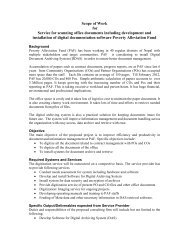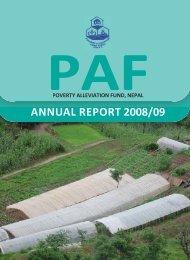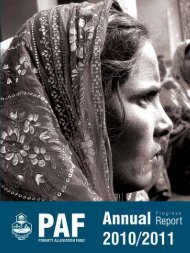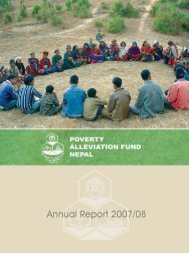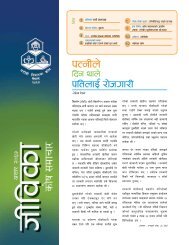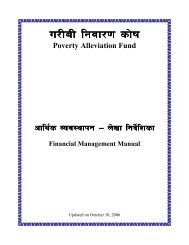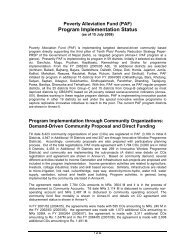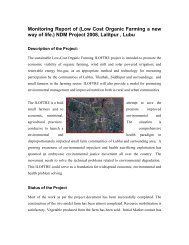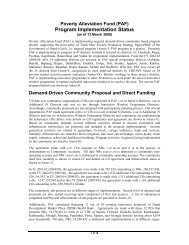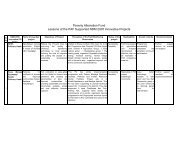Fiscal year 2010/11 - Poverty Alleviation Fund, Nepal
Fiscal year 2010/11 - Poverty Alleviation Fund, Nepal
Fiscal year 2010/11 - Poverty Alleviation Fund, Nepal
You also want an ePaper? Increase the reach of your titles
YUMPU automatically turns print PDFs into web optimized ePapers that Google loves.
Chapter 1:<br />
Introduction<br />
1.1. PAF introduction<br />
A quarter of the <strong>Nepal</strong>i population still lives below poverty line. The<br />
majorities of the poor live predominantly in rural areas and engage in<br />
traditional and subsistence farming on small plots of low quality land,<br />
have limited access to credit, infrastructure, markets and basic social<br />
services, often because of remoteness, and rely heavily on seasonal<br />
migration and remittance.<br />
<strong>Poverty</strong> <strong>Alleviation</strong> <strong>Fund</strong> (PAF) was established in 2004 as a special<br />
and targeted programme to bring the excluded communities in the<br />
mainstream of development, by involving the poor and disadvantaged<br />
groups themselves in the driving seat of development efforts. PAF is<br />
contributing on bringing the level of poverty down to 10 per cent in<br />
20 <strong>year</strong>s in pursuant with the long term goal of Government of <strong>Nepal</strong>;<br />
and reduce poverty by half by the <strong>year</strong> 2015 as per the Millennium<br />
Development Goals (MDGs).<br />
1.2. The Strategy<br />
PAF has taken strategy to enable poor people through social mobilization<br />
and capacity building to organize and obtain quality basic services in<br />
cost-effective and sustainable manner with their direct involvement.<br />
PAF uses Partner Organizations (POs) to help facilitate poor vulnerable<br />
people and their community Groups or Organizations to implement the<br />
programme components, and they include local bodies, NGOs/ CBOs<br />
and private sector organizations. PAF also seeks to forge partnership<br />
with various organizations working in its areas of operation at the<br />
village, district and national level in order to ensure holistic development<br />
intervention to bring discernible impact on poverty reduction and scaling<br />
up the programmes in considerably less time<br />
1.3. The Approach<br />
PAF has followed six guiding principles: namely (a) Targeted to the poor<br />
(Antodaya) (b) Social Inclusion (Samabesi) (c) Demand Driven approach<br />
(Maag Anusar) (d) Transparency (Pardarsita), (e) Direct funding to<br />
community organizations of the poor (Prataksha Bhuktani), and (f)<br />
Community Institutional Development (Samudaya Ko Sansthagat Bikash).<br />
Social Mobilization, Income Generation, Small Community<br />
Infrastructure Development and Capacity Building are the four major<br />
programme components of PAF. The target beneficiaries of PAF are the<br />
poor women, Dalit, Janajatis, and the vulnerable communities living<br />
below the poverty line.<br />
1.4. Institutional Arrangements<br />
Initially established by an ordinance in 2004, PAF is governed by an act<br />
since 2006, thus PAF is an autonomous, independent and professional<br />
organization governed by separate law. The 12- member governing<br />
board, chaired by the Prime Minister, is responsible for policy guidance<br />
and programme approval.<br />
Vice-chairperson and 5 members- are appointed by the government from<br />
among the development professionals while other 5 ex-officio members<br />
include National Planning Commission (NPC) Secretary, Chairman of<br />
the Association of District Development Committees of <strong>Nepal</strong> (ADDCN),<br />
Chairman of Association of Village Development Committees of <strong>Nepal</strong><br />
(AVDCN), Chairman of National Women Commission (NWC), and<br />
Chairman of National Dalit Commission (NDC).<br />
Currently, the PAF secretariat consists of 62 staffs, mostly professional,<br />
recruited on a competitive basis. A total of 370 partner organizations<br />
work on behalf of the poor in 40 programme districts.<br />
1.5. Programme Components<br />
(a) Small-Scale Village and Community Infrastructure: Given the<br />
remoteness of many communities and the virtual non-existence of public<br />
infrastructure services, small investments in infrastructure and services<br />
can make a significant difference to poor communities. The communities<br />
are often very clear on what they need, and are willing to contribute to<br />
sub-projects within their means. Consideration is given to sub-projects<br />
already included in VDC plans and/or where the District Development<br />
Committee (DDC) and/or VDC are prepared to provide matching grants.<br />
Key selection criteria include the number of target households that would<br />
benefit and the expected employment impact. In addition, infrastructure<br />
sub-projects would require communities to prepare and commit to a<br />
realistic Operations and Maintenance (O&M) plan. Partner organizations<br />
ANNUAL PROGRESS REPORT (<strong>2010</strong>/20<strong>11</strong>) 1




